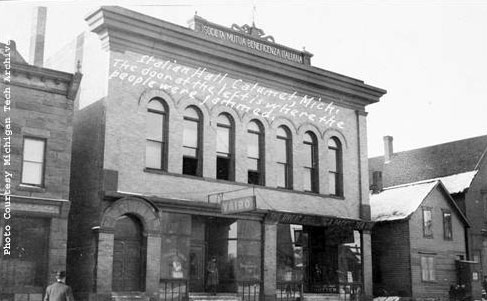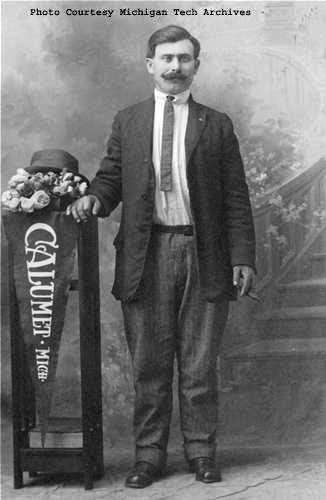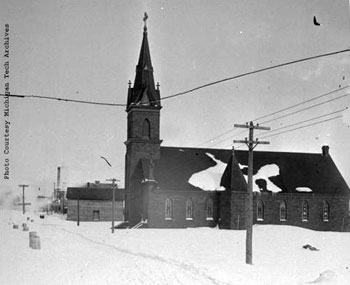Between 1880 and 1920, nearly four million Italians
immigrated to the United States (Ital
1). As was the case with most European emigrants
during this period, land pressure was the central “push
factor” in their emigration. A rising Italian
population increased pressure on the land. Between
1861 and 1901 Italy’s population doubled from
6 to 12 million and then increased to 18 million
by 1916 (Ital
2). In southern Italy the land problem was most
acute, as nearly all the land was owned by small
elite who ruthlessly exploited the landless peasants
working the land. It is therefore not surprising
that the overwhelming majority of Italians who immigrated
to the United States came from southern Italy. Indeed,
in the decades between 1890 and 1910, about 85% of
Italians who immigrated to the United States were
from southern Italy (Ital
3).
Contrary to this larger geographic
pattern of Italian immigration to the United States,
the Italian community in Michigan’s Copper
Country was principally drawn (over 90%) from northern
Italy (Ital
4). Advancements in agriculture in northern Italy,
that is, crop rotation and mechanization, improved
the life of peasants but simultaneously increased
population and reduced the need for agricultural
labor (Ital
5). Northern Italy did experience moderate industrialization
but the labor demands of that industrialization did
not equal the labor surplus produced by improvements
in agriculture. As such, many northern Italians were
forced to emigrate, though clearly not at the rate
of southern Italians.
Our understanding of the Italian community in the
Copper Country has greatly benefited from the scholarship
of Russell Magnaghi (Ital
6) and more recently Cristina Menghini’s
master thesis: “Examining Patterns of Italian
Immigration to Michigan’s Houghton County,
1860-1930 (Ital
7).” Menghini’s study, the most
detailed migration study of any immigrant group in
the Copper Country, uncovered specific chain migration
links between ‘sending communities’ in
northern Italy and ‘receiving communities’ in
Houghton County. Half of the Italians in Houghton
County had emigrated from the province of Torino,
in the Piedmont region, and another quarter had emigrated
from the province of Lucca, in the Tuscany region (Ital
8). Thus three-quarters of Italians in Houghton
County had emigrated from just two of Italy’s
110 provinces.
One of the more interesting discoveries
in Menghini’s study regarded settlement patterns
in Houghton Country and chain migration. Calumet
and South Range (Ital
9) emerged as the two main destinations for Italian
immigrants, with half living in Calumet and a quarter
living in South Range. In Calumet, Italians from
Torino numerically dominated while in South Range,
Italians from Lucca numerically dominated (Ital
10). Not surprisingly, Menghini found that nearly
three-quarters of Italians in Houghton Country in
1910 worked either in the mines or mine related occupations (Ital
11).
Italians had immigrated to the Copper
County as early as the 1860s but did not appear in
large numbers until the 1890s. By the turn of the
century, the Italian Immigrant community accounted
for seven percent of the foreign born population
in Houghton County and was the largest Italian Immigrant
community in Michigan (Ital
12). Indeed, in 1900 a quarter of the entire
foreign-born Italian population in Michigan resided
in Houghton County (Ital
13). By 1920, Italian immigrants accounted for
10% of the foreign born population in Houghton County,
making them the third largest immigrant group behind
the Finns and the Cornish (Ital
14).
Numerical census data, however,
does not clarify whether the Italians enumerated
in 1910 were the same Italians enumerated in 1920.
Many probably were not, as there appears to have
been a high degree of fluidity with the Italian immigrant
community. Scholars have estimated that nearly half
(48%) of the northern Italians who immigrated into
the United States returned back to Italy (Ital
15). A 1910 Report to the Senate Immigration
Commission, which surveyed over 500 Italians in the
Copper Country, found that nearly a quarter (24%)
had returned home at least once since their initial
immigration to the United States (Ital
16). The attachment to the “old country” for
many Italian immigrants on the Keweenaw transcended
ethnic bonds as 44% of the Italians survived in the
Immigration Commission Report had their wives living
back in Italy (Ital
17).
Similar to all large immigrant communities
in the copper country, Italians formed numerous religious,
cultural, fraternal, beneficial, political and social
organizations to help maintain community identity
while simultaneously assisting with their transition
into the larger American society. First among these
Italian American organizations were mutual benefit
societies that collected dues and served as an insurance
pool to be extended to members in times of financial
stress, such as an illness, an injury or death. Established
in 1875, the Italian Mutual Beneficial Society was
the first such Italian organization in the Copper
Country. It built a series of Italian Halls, which
were rented as a meeting place for various ethnic
and social organizations in Calumet. Like many mutual
benefit societies, the Italian Mutual Beneficial
Society transformed itself in a social organization.
It was through such organizations that Italian immigrants
and their children located housing, found work, organized
into political blocks and met their prospective mates.
Italians in Calumet also created the Italian Cooperative
Store in 1912 while Italians in South Range united
with Croatians to establish South Range Cooperative
Store in 1907 (Ital
18).
Italians in the Copper Country also
produced a number of newspapers and periodicals in
their native language. Il Minatore Italiano, (The
Italian Miner) was daily newspaper that ran from
1896 until the 1930s (Ital
19). Although published in Laurium, Il Minatore
Italiano served the larger Italian reading community
in the Copper Country. Italian socialists published
La Sentinella (The Sentinel) from 1896 to 1903 and
the L’Indipendente (The Independent) was launched
in Hancock in 1917 (Ital
20). In Calumet, the Legion of the Knights of
Romulus published Pro Norbis (For Us), a monthly
review, which sought to promote Italian culture and
to combat the view that Italians were ignorant (Ital
21). This struggle was common among Italian Americans
who, as an ethnic group, encountered the greatest
bigotry and discrimination of any European ethnic
group. In general, the American press portrayed Italians
dangerous, cruel, bloodthirsty and lazy (Ital
22). The Report of the Immigration Commission
noted the view of mine owners towards their Italian
workers: “North Italians have been found available
and efficient for the lower positions requiring little
degree of skill. In this connection it should be
noted the North Italian in the section [Michigan’s’ Copper
Country] is held in much greater respect than is
the South Italian. There is little or no prejudice
against the North Italian (Ital
23).”

|
|
The brief memoirs of Vincensa Galetti
Feather take us beyond the numbers of immigration,
the push and pull factors, and ethnic institutions
and offer a glimpse in to the lives of the Italian
immigrants in the Copper Country. Her father emigrated
in 1898 from the small village of San Giorgio, Canavese
in Piedmont to join his brother who lived in Calumet.
The following year, her mother followed and her parents
were wed at St. Mary’s church, a predominantly
Italian Catholic parish church in Calumet. They later
moved to South Range where her father worked in the
Baltic Mine. Vincensa recalled that the Italians
in her neighborhood created beautiful vegetable gardens
and that her family had a cow for milk and cheese,
a pig for sausage and pork and chickens for eggs
and meat. In the fall, her family would join their
neighbors to make wine. On every Saturday night,
her family would go to Santori’s Hall, above
Santori’s Saloon, which, see added, “was
a very clean and proper place.” At the Hall,
her family would join with other Italian families
and dance and sing Italian songs. She also remembered
going to Calumet to attend mass at St. Mary’s
and was there in 1913 to watch the long funeral procession
for the victims of the Italian Hall disaster, her
cousin Kate being among the victims.
In closing, she remarked: “I
wish to pay homage to those pioneers of the Copper
Country, our parents who toiled, rejoiced and sorrowed
there…. It was in that melting pot that we
first learned the meaning of brotherhood, understanding,
love of neighbor and most of all, that glorious lesson
of endurance.” She also wanted to pay homage
to those who taught the children of the foreign born
as they blended the cultures of the old world with
the new and showed their students the golden door
of opportunity. Vincensa, of course, was among those
children and she took advantage of those opportunities.
She graduated from Painsedale High School and went
on to train as teacher at the normal school at Marquette
(Northern Michigan University). After graduation,
she returned to the Copper County to teach for a
year at the Painsedale Junior High School. But like
many of her generation, she left the Copper Country,
in her case, for a teaching job in Detroit (Ital
24).
|




